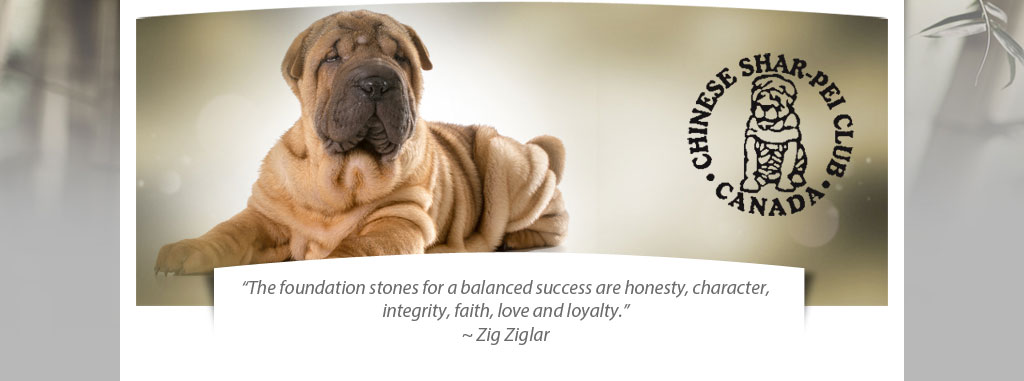Breed Standard
Effective January 1, 2006 as approved by the CKC.
Origin and Purpose
It is generally accepted that the Chinese Shar-Pei originated during the Han Dynasty (202 BC–220 AD) in the village of Dah-Let near the South China Sea. These dogs were all-purpose working dogs to guard the family, farms, and temples.
General Appearance
An alert, dignified, active, compact dog of medium size and substance, square in profile, close-coupled, the well-proportioned head slightly but not overly large for the body. The short, harsh coat, the loose skin covering the head and body, the small ears, the “hippopotamus” muzzle shape, and the high set tail impart to the Shar-Pei a unique look peculiar to him alone. The loose skin and wrinkles covering the head, neck, and body are superabundant in puppies but these features may be limited to the head, neck, and withers in the adult.
Temperament
Regal, alert, intelligent, dignified, lordly, scowling, sober, and snobbish; essentially independent and somewhat standoffish with strangers, but extreme in devotion to family. The Shar-Pei stands firmly on the ground with a calm, confident stature.
Size, Proportion, Substance
The height is 18 to 20 inches (45–50 cm) at the withers. The weight is 40 to 60 pounds (18–27 kg). The dog is usually larger and more square-bodied than the bitch but both appear well-proportioned.
Proportion: Height from the ground to the withers is approximately equal to the length from the point of breastbone to the point of rump.
Coat and Colour
Coat: The extremely harsh coat is one of the distinguishing features of the breed. The coat is absolutely straight and offstanding on the main trunk but generally lies somewhat flatter on the limbs. It appears healthy without being shiny or lustrous. Acceptable coat lengths range from extremely short “horse coat” up to the “brush coat,” not to exceed one inch (2.5 cm) at the withers. A soft coat, a wavy coat, a coat over one inch at the withers, or a trimmed coat is a major fault. One coat type is not preferred over the other. The Shar-Pei is shown in its natural state.
Colour: Only solid colours and sable are acceptable and judged on an equal basis. A solid coloured dog may have shading, primarily darker down the back and on the ears. The shading must be variations of the same body colour (except in sables) and may include darker hairs throughout the coat. A pigmented dog may have a darker mask.
Head
Large—slightly but not overly—proudly carried and covered with profuse wrinkles on the forehead continuing into side wrinkles framing the face.
Eyes: Dark, small, almond-shaped, deep set, scowling expression. In dilute colours the eye colour may be lighter.
Ears: Extremely small, rather thick, equilateral triangles, slightly rounded tips; edges may curl. Ears lie flat, set wide apart and forward, pointing toward the eyes. Mobile.
Skull: Flat and broad; stop moderately defined.
Muzzle: Distinctive; broad and full with no snipiness. Length nose-to-stop approximately equal to stop-to-occiput.
Nose: Large, wide, darkly pigmented—preferably black—but any colour conforming to the coat is acceptable. In dilute colours, self-coloured preferred. Darkly pigmented creams may show lighter pigment in the centre or entire nose.
Flesh pigmentation: Lips and top of muzzle well padded, possibly causing a slight bulge at the base of the nose.
Tongue, roof of mouth, gums, flews: Solid bluish-black preferred in all coat colours, except dilute colours which have solid lavender pigmentation. A spotted tongue is a major fault. A solid pink tongue is a disqualification (tongues may lighten due to heat stress; do not confuse dilute pigmentation with a pink tongue).
Teeth
Strong, meeting in a scissors bite. Deviation from a scissors bite is a major fault.
Neck
Medium length, full, set well into the shoulders, with moderate to heavy loose skin and abundant dewlap about the neck and throat.
Forequarters
Shoulders: Muscular, well laid back and sloping.
Forelegs: From the front, straight, moderately spaced, elbows close. From the side, straight with strong, flexible pasterns. Bone substantial but never heavy; moderate length. Front dewclaw removal optional.
Feet: Moderate size, compact, firm, not splayed.
Body
Topline: Slight dip behind the withers, slightly rising over the short, broad loin. A level, roached, or swayed topline shall be faulted.
Chest: Broad and deep; brisket to elbow, rising slightly under the loin.
Back: Short, close-coupled.
Croup: Flat, with tail set extremely high, clearly exposing an uptilted anus.
Hindquarters
Muscular, strong, moderately angulated. Metatarsi (hocks) short, perpendicular, and parallel when viewed from the rear. Hind dewclaws must be removed. Feet as in front.
Tail: High set—characteristic of the breed. A low tail shall be faulted. Thick and round at the base, tapering to a fine point and curling over either side of the back. Absence of a complete tail is a disqualification.
Gait
Judged at a trot. Free and balanced; feet tend to converge toward a centre line at a vigorous trot, combining good forward reach with strong rear drive. Proper movement is essential.
Major Faults
- Deviation from a scissors bite.
- Spotted tongue.
- Soft coat, wavy coat, coat over 1" (2.5 cm) at withers, or trimmed coat.
Disqualifications
- Pricked ears.
- Solid pink tongue.
- Absence of a complete tail.
- Not a solid colour (e.g., Albino; Brindle; Parti-coloured patches; spotted including ticking/roaning; Tan-Pointed patterns including typical black-and-tan or saddled patterns; or shading with a defined “butterfly” chest pattern).



